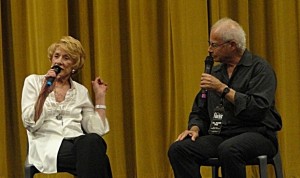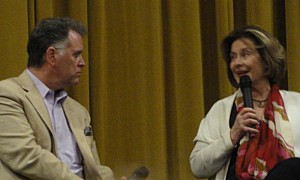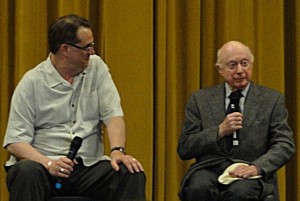“There’s a name for someone who says, ‘I can’t watch a movie in black and white.’ Stupid!”
So said Frank DeCaro, author of “The Dead Celebrity Cookbook,” last night at a book signing in West Hollywood. A writer, critic and performer, DeCaro hosts a morning call-in program on Sirius XM satellite radio and writes the Icons column for CBS’ Watch! magazine.
He also likes to cook and throw parties. When the celebs were kind enough to die, as he puts it, the book seemed a natural. Highlights from noiristas include: Otto Preminger’s Deviled Eggs, Joan Crawford’s Poached Salmon, Bette Davis’ Red Flannel Hash, Lucille Ball’s Sunday Night Goulash, Fred MacMurray’s Flemish Pot Roast, Truman Capote’s Fettuccine, Anthony Perkins’ Tuna Salad, Alfred Hitchcock’s Quiche Lorraine, Janet Leigh’s Gâteau Doré, Agnes Moorehead’s Lobster Mousse, William Holden’s Hamburgers à la Hong Kong and Gregory Peck’s Ratatouille.
DeCaro’s favorite: Liberace’s Sticky Buns. “If Liberace didn’t know how funny that was, then the whole world crumbles,” said DeCaro. He is up front that he did not test every recipe, particularly Don Ho’s pigs’ feet soup. DeCaro suggests not picking Crawford’s salmon as a first effort. “Don’t start with Joan Crawford; that’s always good advice.”
And be warned: because many of the recipes are retro, they might call for fat-gram disasters like canned cream of mushroom soup. “You have to remember that frozen and canned food was not considered tacky,” he said. “It was considered modern, instant, groovy!”
Having spent 15 years collecting recipes, DeCaro also has plenty of noshing trivia. Did you know that per capita Hawaii eats the most SPAM and Utah eats the most JELL-O?
Granted, the book might cause some to wince or groan (he includes a pie recipe from Karen Carpenter). One detractor told DeCaro she thought his book was “highly offensive and exceedingly faggy,” which pleases DeCaro to no end. He is now working on a Christmas edition.
Speaking of maximizing opportunity, DeCaro’s domestic advice was not limited to the kitchen. He’s fond of telling his husband Jim Colucci: “You cannot sleep with anyone but me. Unless it’s good for your career.”
“The Dead Celebrity Cookbook: A Resurrection of Recipes from More Than 145 Stars of Stage and Screen” (HCI Books, $19.95)

























![220px-Loophole[1]](http://www.filmnoirblonde.com/wp-content/uploads/2011/05/220px-Loophole11-196x300.jpg)


![220px-DamnedDontCry[1]](http://www.filmnoirblonde.com/wp-content/uploads/2011/05/220px-DamnedDontCry11-210x300.jpg)





From FNB readers